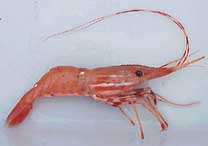
Dall's porpoise is a species of porpoise endemic to the North Pacific. It is the largest of porpoises and the only member of the genus Phocoenoides. The species is named after American naturalist W. H. Dall.

Whiteleg shrimp, also known as Pacific white shrimp or King prawn, is a species of prawn of the eastern Pacific Ocean commonly caught or farmed for food.

Litopenaeus setiferus is a species of prawn found along the Atlantic coast of North America and in the Gulf of Mexico. It was the subject of the earliest shrimp fishery in the United States.

The chum salmon, also known as dog salmon or keta salmon, is a species of anadromous salmonid fish from the genus Oncorhynchus native to the coastal rivers of the North Pacific and the Beringian Arctic, and is often marketed under the trade name silverbrite salmon in North America. The English name "chum salmon" comes from the Chinook Jargon term tzum, meaning "spotted" or "marked"; while keta in the scientific name comes from Russian, which in turn comes from the Evenki language of Eastern Siberia. The term 'Dog Salmon' is most commonly used in Alaska and refers to the Salmon whose flesh Alaskans use to feed their dogs.

Pandalus borealis is a species of caridean shrimp found in cold parts of the northern Atlantic and northern Pacific Oceans, although the latter population now often is regarded as a separate species, P. eous. The Food and Agriculture Organization refers to them as the northern prawn. Other common names include pink shrimp, deepwater prawn, deep-sea prawn, Nordic shrimp, great northern prawn, northern shrimp, coldwater prawn and Maine shrimp.

The coho salmon is a species of anadromous fish in the salmon family and one of the five Pacific salmon species. Coho salmon are also known as silver salmon or "silvers". The scientific species name is based on the Russian common name kizhuch (кижуч).

The shrimp fishery is a major global industry, with more than 3.4 million tons caught per year, chiefly in Asia. Rates of bycatch are unusually high for shrimp fishing, with the capture of sea turtles being especially contentious.

The Pacific herring is a species of the herring family associated with the Pacific Ocean environment of North America and northeast Asia. It is a silvery fish with unspined fins and a deeply forked caudal fin. The distribution is widely along the California coast from Baja California north to Alaska and the Bering Sea; in Asia the distribution is south to Japan, Korea, and China. Clupea pallasii is considered a keystone species because of its very high productivity and interactions with many predators and prey. Pacific herring spawn in variable seasons, but often in the early part of the year in intertidal and sub-tidal environments, commonly on eelgrass, seaweed or other submerged vegetation; however, they do not die after spawning, but can breed in successive years. According to government sources, the Pacific herring fishery collapsed in the year 1993, and is slowly recovering to commercial viability in several North American stock areas. The species is named for Peter Simon Pallas, a noted German naturalist and explorer.
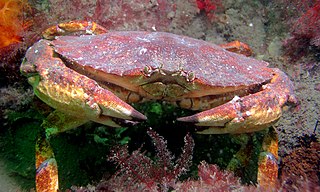
Cancer productus, one of several species known as red rock crabs, is a crab of the genus Cancer found on the western coast of North America. This species is commonly nicknamed the Pearl of the Pacific Northwest.

Palaemon serratus, also called the common prawn, is a species of shrimp found in the Atlantic Ocean from Denmark to Mauritania, and in the Mediterranean Sea and Black Sea.
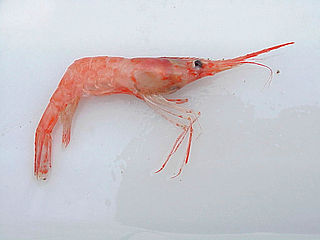
Pandalus is a genus of shrimp in the family Pandalidae. Members of the genus are medium-sized and live on or near the seabed. Some species are the subject of commercial fisheries and are caught by trawling. One species, Pandalus montagui, lives in association with the reef-building polychaete worm, Sabellaria spinulosa.

Pandalus montagui is a species of cold-water shrimp in the family Pandalidae. It is the type species of the genus Pandalus and is variously known as the pink shrimp, Aesop shrimp and Aesop prawn.

Trachysalambria curvirostris is a species of prawn that lives in shallow waters of the Indo-West Pacific. It is one of the most important species targeted by prawn fishery, with annual harvests of more than 300,000 t, mostly landed in China.

A shrimp is a crustacean with an elongated body and a primarily swimming mode of locomotion – typically belonging to the Caridea or Dendrobranchiata of the decapod order, although some crustaceans outside of this order are also referred to as "shrimp".
Sicyonia ingentis is a species of prawn in the family Sicyoniidae known by the common name ridgeback prawn. It is native to the eastern Pacific Ocean, where it occurs along the coast of California and Baja California, its distribution extending from Monterey Bay to Isla María Madre off Nayarit. It also lives in the Gulf of California. Other common names include Pacific rock shrimp and Japanese shrimp. In Spanish it is called camarón de piedra del Pacífico and cacahuete.

Metapenaeus monoceros is a species of prawn in the family Penaeidae. It is also known as speckled shrimp, brown shrimp and pink shrimp in English, crevette mouchetée in French, camarón moteado in Spanish, koraney chingri or honye chingri in India, ginger prawn in South Africa and choodan chemmeen in Malayalam.
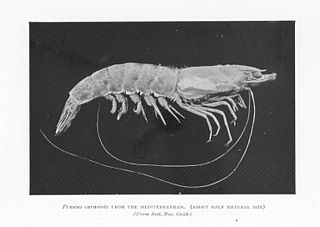
Melicertus kerathurus, the striped prawn or caramote prawn is a species of tiger prawn from the family Penaeidae which occurs in the eastern Atlantic and Mediterranean Sea which is an important species in commercial fisheries. It is the type species for the genus Melicertus.
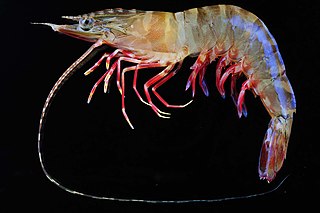
Penaeus semisulcatus, the green tiger prawn or grooved tiger prawn, is a commercially important species of prawn in the genus Penaeus.

Pandalus hypsinotus is a crustacean in the Pandalidae family, ordinarily 10–12.5 centimetres (3.9–4.9 in) in length, but large females may reach 17.5 centimetres (6.9 in). It can be found in the Bering Sea, from the Aleutian Islands to Puget Sound, and in the Sea of Japan at depths of 100–200 metres (330–660 ft).

Pandalus lucidirimicola, the sparkling shrimp, is a species of caridean shrimp in the family Pandalidae.
